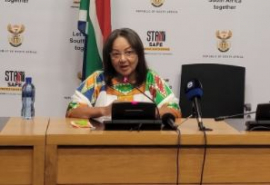
Public Works and Infrastructure Minister Patricia de Lille says the Coega Development Corporation, a service provider appointed to conduct an independent assessment of the extent of the fire damage in Parliament, has completed its preliminary assessment report.
De Lille said this when she briefed the media in Cape Town on Tuesday on the progress of projects in the Infrastructure Investment Plan following President Cyril Ramaphosa’s State of the Nation Address, earlier this month.
“The Coega team has completed the bulk of the preliminary assessment and report on the fire damage to the New National Assembly Building and the Old Assembly Building following the fires of 2 and 3 January 2022.
“The basement floors of the New Assembly Building are flooded and more inspection work needs to be done in this area.
“The assessment confirmed that the fire in the National Assembly building caused significant damage to the central structural elements from the 2nd floor up to the 6th floor, but the structural integrity is such that the structure is not vulnerable to collapse,” de Lille said.
The Coega final structural assessment report has designated three zones within the New National Assembly Building - the Red, Amber and Green Zones.
The colour coding designates areas within the buildings and their status with respect to the SA Police Service's access for their imminent investigations.
Green zones represent areas which are fairly lightly damaged structurally and which may be accessed almost immediately by a properly inducted SAPS team following defined safety protocols.
Amber zones are badly damaged zones which may be accessed almost immediately by properly inducted SAPS teams following defined safety protocols, provided they are accompanied by a member of the Coega structural team.
The red zones are severely damaged “no-go” zones which may not be accessed by SAPS teams.
“Should the investigation trail render access to specific areas within the “no-go” zones to be very desirable, then the structural engineers will advise on special temporary access structures to be constructed.
“Where possible, to allow the investigators access, with due regard to safety, without applying loads to the severely compromised parts of the structure.”
De Lille said the Coega structural engineers have recommended certain short-to-intermediate term safety measures be put in place to safeguard personnel and certain remaining portions of the structure.
She said these measures are recommended to be put in place after the conclusion of the SAPS investigation.
“The Coega team is on track to commence with the second phase comprising the detailed assessment to determine the extent of damage for full restoration of the building, including providing a cost and time estimate for such works.
“The latter will commence after the forensic investigations and should take three weeks to conclude.”
She said Coega’s detailed assessment report will be communicated to the media and public as soon as it has been finalised and will include:
- a detailed assessment report indicating the extent of the damage and any other structural issues;
- pronouncement on the residual strength of the structure (including all relevant tests and analysis);
- proposed restorative measures with associated cost comparisons for restoration;
- proposed time estimate of the rehabilitation project;
- proposed preliminary cost estimate of the rehabilitation project; and
- pronouncement on possible long term restorative measures. – SAnews.gov.za


